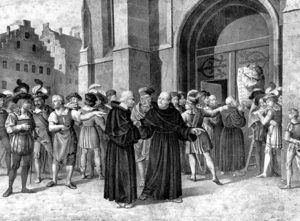Luther's revolt
 Luther displaying his theses in Wittenberg © S.H.P.F.
Luther displaying his theses in Wittenberg © S.H.P.F.
In 1517 Luther initiated a reformation movement by publicising his 95 theses against the indulgences. Thanks to printing his views were widely publicised in Europe. Based on the New Testament, they aimed not only at correcting the abuses of the Catholic Church, but also its doctrine. He wanted to eradicate or modify all that was against the teachings of the New Testament. He wanted a deep reform of the present Church. The refusal of the Pope to listen to him, and the ensuing excommunication led to the breach he had not wished.
The Lutheran Church
Thus was a new Church created called in Germany the evangelical Church, because it claimed a [glosssary_exclude]revival of the gospel.
The new doctrine was summed up in Luther’s two catechisms dated 1529 and in The Augsburg Confession, the work by Philipp Melanchton, his collaborator.
Mass was deeply changed. It was performed in German and no longer in Latin and based on :
- preaching the Gospel,
- singing hymns (Luther composed several of them),
- the Eucharist or Holy Cmmunion in both kinds – i.e. bread and wine.
The Virgin Mary, the saints and the dead were no longer worshipped.
The spreading of lutheranism
Throughout the German empire, the Lutheran Reformation spread over princes’ states and many cities in Northern Germany.
Luther appealed to princes for their support to found the new Church and to guarantee the appropriate form of worship.
The Lutheran Reformation also spread to Denmark and Norway, where national Churches were promoted by sovereigns.
In the kingdom of France, only the Reformed churches gained a foothold.